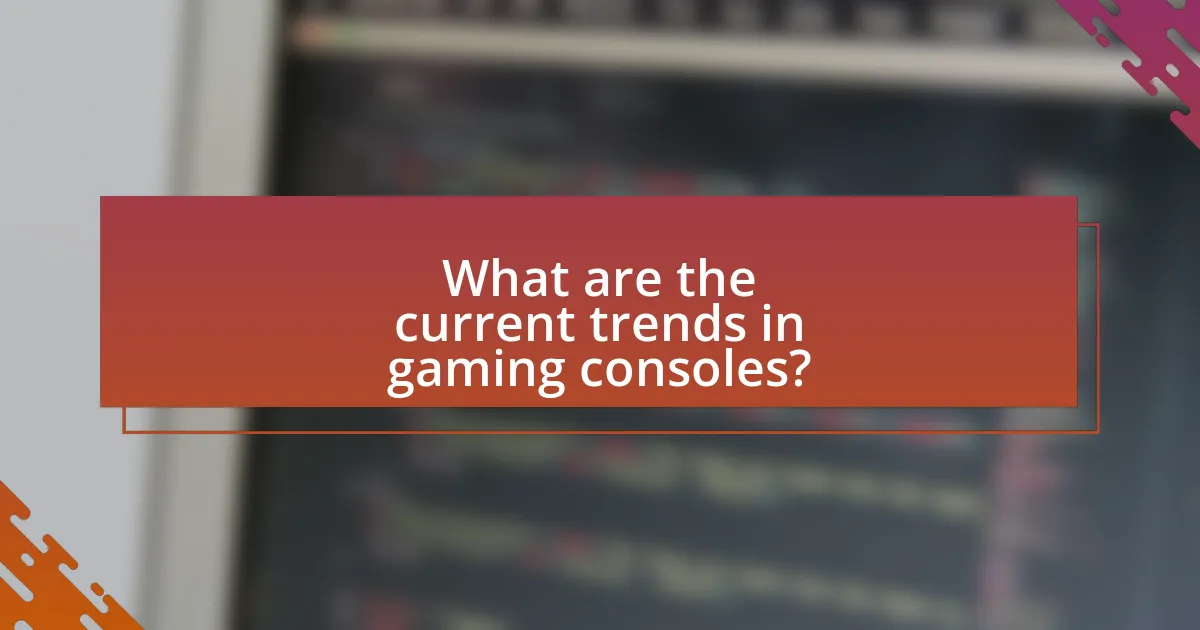The article focuses on the evolution of gaming consoles, tracing their development from the Magnavox Odyssey in the 1970s to the latest advancements in 2023. It highlights key milestones, such as the introduction of cartridge-based systems, the rise of 3D graphics, and the impact of online gaming. The discussion includes the influence of technological advancements on console design, the distinction between home and handheld devices, and the emergence of cloud gaming and virtual reality. Additionally, it examines current trends, future innovations, and the importance of understanding this evolution for gamers to adapt to changing technologies and preferences.

What is the Evolution of Gaming Consoles?
The evolution of gaming consoles began in the early 1970s with the release of the Magnavox Odyssey, the first home video game console. This was followed by the introduction of the Atari 2600 in 1977, which popularized cartridge-based games and established the home gaming market. The 1980s saw the rise of Nintendo with the NES, which revitalized the industry after the video game crash of 1983, introducing iconic franchises like Super Mario Bros.
In the 1990s, Sony entered the market with the PlayStation, which emphasized 3D graphics and CD-ROM technology, leading to a shift in gaming experiences. The Sega Dreamcast followed, introducing online gaming capabilities. The early 2000s marked the launch of Microsoft’s Xbox, which further advanced online multiplayer gaming and introduced the Xbox Live service.
The mid-2000s brought the seventh generation of consoles, including the Xbox 360, PlayStation 3, and Nintendo Wii, each innovating with motion controls, high-definition graphics, and online services. The eighth generation, starting in 2013, included the Xbox One, PlayStation 4, and Nintendo Switch, focusing on social gaming, streaming services, and hybrid gaming experiences.
As of 2023, the gaming console landscape continues to evolve with advancements in cloud gaming, virtual reality, and enhanced graphics capabilities, indicating a trend towards more immersive and interconnected gaming experiences.
How have gaming consoles changed over the decades?
Gaming consoles have evolved significantly over the decades, transitioning from simple, cartridge-based systems to complex, internet-connected devices. In the 1970s, the first generation of consoles, like the Magnavox Odyssey, offered basic gameplay with limited graphics and sound. The 1980s introduced 8-bit systems such as the Nintendo Entertainment System, which featured improved graphics and a wider variety of games. The 1990s saw the advent of 16-bit and 32-bit consoles, like the Sega Genesis and Sony PlayStation, which provided enhanced graphics, CD-ROM capabilities, and 3D gaming experiences.
In the 2000s, consoles like the Xbox and PlayStation 2 integrated online gaming and multimedia functions, allowing users to play games, watch DVDs, and connect to the internet. The introduction of high-definition graphics in the mid-2000s with the Xbox 360 and PlayStation 3 marked a significant leap in visual fidelity. The latest generation, including the PlayStation 5 and Xbox Series X, emphasizes cloud gaming, virtual reality, and cross-platform play, reflecting a shift towards more immersive and interconnected gaming experiences. This evolution illustrates the industry’s response to technological advancements and changing consumer preferences.
What were the key milestones in the history of gaming consoles?
The key milestones in the history of gaming consoles include the release of the Magnavox Odyssey in 1972, which was the first home video game console, followed by the Atari 2600 in 1977, which popularized cartridge-based gaming. In 1983, the video game crash led to a decline in the industry, but the introduction of the Nintendo Entertainment System (NES) in 1985 revitalized it with iconic titles like Super Mario Bros. The Sony PlayStation launched in 1994, marking the shift to 3D graphics and CD-ROM technology. The introduction of online gaming with the Sega Dreamcast in 1998 and the launch of the Xbox in 2001 further transformed the landscape. The PlayStation 2, released in 2000, became the best-selling console of all time, and the Wii, released in 2006, popularized motion controls. The PlayStation 4 and Xbox One, released in 2013, emphasized social gaming and multimedia capabilities, while the Nintendo Switch, launched in 2017, introduced hybrid gaming. Each of these milestones significantly shaped the evolution of gaming consoles and their impact on the gaming industry.
How did technological advancements influence console development?
Technological advancements significantly influenced console development by enabling enhanced graphics, processing power, and online connectivity. For instance, the introduction of 3D graphics in the mid-1990s, exemplified by the Sony PlayStation, revolutionized gaming experiences, allowing for more immersive environments and complex gameplay. Additionally, the transition from cartridge-based systems to CDs and later to digital downloads facilitated larger game sizes and improved audio-visual quality. The development of high-speed internet in the 2000s further transformed consoles, enabling online multiplayer gaming and digital distribution, as seen with the Xbox Live service launched in 2002. These advancements collectively shaped the gaming landscape, driving consumer expectations and influencing the design and functionality of subsequent consoles.
What are the major types of gaming consoles?
The major types of gaming consoles are home consoles, handheld consoles, and hybrid consoles. Home consoles, such as the PlayStation 5 and Xbox Series X, are designed for stationary use and connect to televisions, providing high-performance gaming experiences. Handheld consoles, like the Nintendo Switch Lite and PlayStation Vita, are portable devices that allow gaming on the go. Hybrid consoles, exemplified by the Nintendo Switch, combine features of both home and handheld consoles, enabling users to play games on a TV or as a portable device. These classifications are based on functionality and design, reflecting the diverse gaming preferences of consumers.
What distinguishes home consoles from handheld devices?
Home consoles are distinguished from handheld devices primarily by their design and intended use; home consoles are designed for stationary use and connect to a television, while handheld devices are portable and designed for on-the-go gaming. Home consoles typically offer more powerful hardware, allowing for advanced graphics and larger game libraries, as seen in systems like the PlayStation 5 and Xbox Series X, which support high-definition gaming and extensive online features. In contrast, handheld devices, such as the Nintendo Switch Lite, prioritize portability and battery life, often sacrificing some graphical capabilities for convenience. This distinction is evident in the gaming experience, where home consoles provide a more immersive environment, while handheld devices cater to casual and mobile gaming needs.
How do retro consoles compare to modern systems?
Retro consoles primarily offer simpler graphics and gameplay mechanics compared to modern systems, which feature advanced graphics, complex gameplay, and online connectivity. Retro consoles, such as the NES or Sega Genesis, typically utilize 8-bit or 16-bit graphics, while modern systems like the PlayStation 5 and Xbox Series X support 4K resolution and high frame rates. Additionally, retro consoles often focus on single-player experiences or local multiplayer, whereas modern systems provide extensive online multiplayer options and downloadable content. The historical significance of retro consoles lies in their foundational role in gaming, while modern systems reflect technological advancements and evolving player expectations.
Why is understanding the evolution of gaming consoles important for gamers?
Understanding the evolution of gaming consoles is important for gamers because it provides insights into technological advancements, gameplay experiences, and industry trends. By studying the progression from early consoles like the Magnavox Odyssey to modern systems such as the PlayStation 5 and Xbox Series X, gamers can appreciate how hardware improvements, such as graphics capabilities and processing power, have enhanced gameplay. Additionally, recognizing the shifts in gaming culture, such as the rise of online multiplayer and digital distribution, helps gamers anticipate future developments and adapt to new gaming environments. Historical context, such as the introduction of 3D graphics in the 1990s or the impact of mobile gaming, further illustrates how past innovations shape current and future gaming experiences.
How does the history of consoles impact current gaming trends?
The history of consoles significantly impacts current gaming trends by establishing foundational technologies and consumer expectations. For instance, the introduction of 3D graphics in the 1990s with consoles like the Sony PlayStation set a standard for immersive gameplay that continues to influence game design today. Additionally, the shift towards online multiplayer gaming, initiated by consoles such as the Xbox Live service in the early 2000s, has led to a persistent demand for social connectivity in modern games. Furthermore, the evolution of hardware capabilities, from cartridge-based systems to today’s powerful GPUs, has enabled developers to create more complex and visually stunning games, shaping player preferences and market trends. These historical milestones illustrate how past innovations directly inform current gaming experiences and consumer behavior.
What lessons can be learned from past console failures and successes?
Lessons learned from past console failures and successes include the importance of understanding consumer needs, the necessity of robust marketing strategies, and the value of backward compatibility. For instance, the failure of the Sega Saturn was largely attributed to its rushed launch and lack of consumer awareness, while the success of the PlayStation 2 stemmed from its extensive game library and DVD playback feature, which appealed to a broader audience. Additionally, the Xbox 360’s success was bolstered by its online services and community engagement, highlighting the need for ongoing support and innovation. These examples illustrate that aligning product features with market demands and maintaining strong consumer relationships are critical for success in the gaming console industry.

What are the current trends in gaming consoles?
Current trends in gaming consoles include the rise of cloud gaming, increased focus on cross-platform play, and the integration of virtual reality (VR) and augmented reality (AR) technologies. Cloud gaming services, such as Xbox Cloud Gaming and PlayStation Now, allow players to stream games without the need for powerful hardware, making gaming more accessible. Cross-platform play is becoming standard, enabling gamers on different consoles to play together, which enhances the gaming community. Additionally, major console manufacturers are investing in VR and AR capabilities, as seen with PlayStation VR2, to create immersive gaming experiences. These trends reflect the industry’s shift towards greater accessibility, community engagement, and technological innovation.
How are cloud gaming and streaming services changing the console landscape?
Cloud gaming and streaming services are significantly altering the console landscape by enabling gamers to access high-quality games without the need for expensive hardware. This shift allows players to stream games directly to various devices, reducing the reliance on traditional consoles. For instance, services like Xbox Cloud Gaming and PlayStation Now offer extensive libraries of games that can be played on smartphones, tablets, and PCs, demonstrating a move towards a more flexible gaming experience. According to a report by Newzoo, the global cloud gaming market is expected to reach $1.6 billion by 2025, indicating a growing acceptance and demand for these services. This trend challenges the traditional console model, as consumers may prioritize subscription-based access over purchasing new hardware, thereby reshaping the future of gaming consoles.
What are the benefits and drawbacks of cloud gaming for console users?
Cloud gaming offers console users benefits such as reduced hardware costs and instant access to a vast library of games without the need for downloads or updates. This model allows users to play high-quality games on lower-end devices, as processing is handled remotely on powerful servers. However, drawbacks include reliance on a stable internet connection, which can lead to latency issues and affect gameplay quality. Additionally, subscription fees for cloud gaming services can accumulate over time, potentially surpassing the cost of purchasing games outright.
How do streaming services influence game availability and pricing?
Streaming services significantly influence game availability and pricing by providing a platform for instant access to a wide range of titles, often at a lower cost than traditional purchasing methods. These services, such as Xbox Game Pass and PlayStation Now, allow subscribers to access a library of games for a monthly fee, which can reduce the overall cost of gaming for consumers. For instance, Xbox Game Pass offers over 100 games for a flat monthly rate, making it more economical compared to purchasing individual titles at retail prices, which can range from $30 to $70 each. Additionally, streaming services can enhance game availability by allowing players to access games across multiple devices without the need for physical copies, thus increasing the reach of both indie and major titles. This model encourages developers to release games on these platforms, knowing they can reach a larger audience, which can further influence pricing strategies as competition among titles increases.
What role does virtual reality play in the future of gaming consoles?
Virtual reality (VR) is set to play a transformative role in the future of gaming consoles by enhancing immersion and interactivity. As gaming technology evolves, VR offers players a more engaging experience through realistic environments and interactive gameplay. For instance, the introduction of VR headsets, such as the PlayStation VR and Oculus Quest, has already demonstrated significant consumer interest, with the VR gaming market projected to reach $12 billion by 2024, according to a report by Statista. This growth indicates that gaming consoles will increasingly integrate VR capabilities, allowing for new genres and gameplay mechanics that leverage spatial awareness and physical movement.
How are current consoles integrating VR technology?
Current consoles are integrating VR technology by offering dedicated VR headsets and supporting VR-compatible games. For instance, PlayStation 5 supports the PlayStation VR2 headset, which features advanced haptic feedback and eye tracking, enhancing immersion in gaming experiences. Additionally, Xbox Series X has shown interest in VR through partnerships and software development, although it has not yet released a dedicated VR headset. These integrations demonstrate a commitment to expanding the gaming experience through virtual reality, as evidenced by the growing library of VR titles available on these platforms.
What are the potential challenges of VR adoption in gaming?
The potential challenges of VR adoption in gaming include high costs, technical limitations, and user discomfort. High costs are a significant barrier, as VR headsets and compatible hardware can exceed several hundred dollars, limiting accessibility for many gamers. Technical limitations, such as the need for powerful computers and the potential for latency issues, can hinder the overall experience. User discomfort, including motion sickness and fatigue from prolonged use, poses a challenge to sustained engagement with VR gaming. According to a study published in the journal “Virtual Reality,” approximately 40% of users experience some form of motion sickness when using VR systems, highlighting the need for improved technology to address these issues.
What innovations are expected in the next generation of gaming consoles?
The next generation of gaming consoles is expected to feature innovations such as enhanced graphics capabilities, faster load times, and improved AI integration. These advancements will be driven by more powerful hardware, including custom processors and increased RAM, allowing for real-time ray tracing and higher frame rates. Additionally, cloud gaming technology is anticipated to become more prevalent, enabling players to stream games directly without the need for extensive local storage. The integration of virtual reality and augmented reality experiences is also expected to expand, providing immersive gameplay. These innovations are supported by trends in the gaming industry, where companies are investing heavily in research and development to meet consumer demand for more engaging and high-quality gaming experiences.
How might hardware advancements enhance gaming experiences?
Hardware advancements significantly enhance gaming experiences by improving graphics, processing power, and overall performance. For instance, the introduction of graphics processing units (GPUs) with ray tracing capabilities allows for more realistic lighting and shadows, creating immersive environments. Additionally, faster processors enable smoother gameplay and quicker load times, reducing lag and enhancing user engagement. The implementation of solid-state drives (SSDs) further accelerates data retrieval, allowing for seamless transitions between game scenes. These advancements collectively contribute to a more engaging and visually stunning gaming experience, as evidenced by the performance improvements seen in next-generation consoles like the PlayStation 5 and Xbox Series X, which utilize cutting-edge hardware to deliver enhanced gameplay.
What new features are gamers looking for in future consoles?
Gamers are looking for enhanced performance and graphics capabilities in future consoles. This includes support for 8K resolution, higher frame rates, and advanced ray tracing technology to improve visual fidelity. Additionally, gamers desire faster load times facilitated by solid-state drives (SSDs) and improved cloud gaming integration for seamless gameplay across devices. According to a survey by the International Game Developers Association, 70% of gamers prioritize performance upgrades in their next console, indicating a strong demand for these features.

What can gamers expect in the future?
Gamers can expect significant advancements in technology, including enhanced graphics, virtual reality integration, and cloud gaming capabilities. These developments will lead to more immersive experiences and greater accessibility. For instance, the introduction of next-generation consoles like the PlayStation 5 and Xbox Series X has already demonstrated improved processing power and graphics capabilities, allowing for more realistic gameplay. Additionally, the rise of cloud gaming services, such as Google Stadia and NVIDIA GeForce Now, is making high-quality gaming accessible on various devices without the need for expensive hardware. This trend indicates a future where gamers can enjoy seamless experiences across platforms, further expanding the gaming community.
How will gaming consoles evolve in terms of user experience?
Gaming consoles will evolve in terms of user experience by integrating advanced technologies such as artificial intelligence, virtual reality, and cloud gaming. These advancements will enhance personalization, allowing consoles to adapt to individual player preferences and behaviors, thereby creating a more immersive and tailored gaming experience. For instance, AI can analyze gameplay patterns to suggest games or adjust difficulty levels in real-time, while virtual reality will provide more engaging environments. Additionally, cloud gaming services, which are projected to grow significantly, will enable players to access high-quality games without the need for expensive hardware, making gaming more accessible. According to a report by Newzoo, the global cloud gaming market is expected to reach $4.8 billion by 2023, indicating a strong shift towards this model.
What improvements in interface and accessibility can be anticipated?
Improvements in interface and accessibility for gaming consoles can be anticipated through enhanced user experience design and adaptive technologies. These advancements will likely include more intuitive navigation systems, voice control features, and customizable interfaces that cater to diverse user needs. For instance, the integration of AI-driven recommendations can streamline game selection and enhance user engagement. Additionally, accessibility features such as adjustable text sizes, colorblind modes, and haptic feedback will support players with disabilities, making gaming more inclusive. Research from the International Game Developers Association indicates that 20% of gamers identify as having a disability, highlighting the necessity for these improvements to accommodate a broader audience.
How might social gaming features change in future consoles?
Social gaming features in future consoles are likely to evolve towards more immersive and integrated experiences, leveraging advancements in technology such as virtual reality (VR) and augmented reality (AR). These technologies will enable players to interact in shared virtual spaces, enhancing social engagement beyond traditional multiplayer formats. For instance, platforms like PlayStation and Xbox have already begun incorporating social features such as cross-platform play and integrated voice chat, which are expected to expand further. Additionally, data from the Entertainment Software Association indicates that 70% of gamers play with friends, highlighting the demand for enhanced social connectivity. Future consoles may also utilize AI to personalize social interactions, suggesting friends to play with based on gaming habits and preferences, thereby fostering a more connected gaming community.
What are the potential impacts of emerging technologies on gaming consoles?
Emerging technologies significantly impact gaming consoles by enhancing performance, improving user experience, and enabling new gaming paradigms. For instance, advancements in cloud gaming allow players to stream high-quality games without the need for powerful hardware, as seen with services like Google Stadia and NVIDIA GeForce Now. Additionally, the integration of virtual reality (VR) and augmented reality (AR) technologies creates immersive gaming experiences, exemplified by platforms like PlayStation VR. Furthermore, artificial intelligence (AI) enhances game design and player interactions, leading to more personalized gaming experiences. These technologies collectively drive innovation in gaming consoles, shaping their future and expanding their capabilities.
How could artificial intelligence enhance gameplay and personalization?
Artificial intelligence could enhance gameplay and personalization by analyzing player behavior and preferences to create tailored gaming experiences. AI algorithms can track individual player actions, such as decision-making patterns and skill levels, allowing games to adapt in real-time, providing challenges that match the player’s abilities. For instance, a study by the International Journal of Human-Computer Interaction found that AI-driven adaptive difficulty systems improve player engagement and satisfaction by adjusting game challenges based on performance metrics. This personalization leads to a more immersive experience, as players feel that the game is responding to their unique style and preferences.
What role will augmented reality play in the future of gaming consoles?
Augmented reality will significantly enhance the immersive experience of gaming consoles in the future. By integrating digital elements into the real world, augmented reality allows players to interact with their environment in novel ways, creating a more engaging gameplay experience. For instance, the success of devices like Microsoft’s HoloLens demonstrates the potential for augmented reality to blend gaming with physical spaces, enabling users to see and interact with game characters and objects as if they were part of their actual surroundings. This technology is expected to drive innovation in game design, leading to more interactive and social gaming experiences, as evidenced by the popularity of AR games like Pokémon GO, which generated over $1 billion in revenue within its first year.
What practical tips can gamers follow to stay ahead in the evolving console landscape?
Gamers can stay ahead in the evolving console landscape by regularly researching upcoming technologies and trends in gaming hardware. Staying informed about advancements such as cloud gaming, cross-platform play, and subscription services allows gamers to make educated decisions about their purchases and gaming experiences. For instance, the rise of cloud gaming platforms like NVIDIA GeForce Now and Xbox Cloud Gaming indicates a shift towards less reliance on physical hardware, suggesting that gamers should consider investing in high-speed internet and compatible devices. Additionally, participating in gaming communities and forums can provide insights into the latest developments and user experiences, further enhancing a gamer’s ability to adapt to changes in the console market.
How can gamers choose the right console based on their preferences?
Gamers can choose the right console based on their preferences by evaluating factors such as exclusive game titles, online services, hardware specifications, and community support. For instance, if a gamer prioritizes exclusive titles like “The Last of Us” or “Halo,” they may prefer PlayStation or Xbox, respectively. Additionally, gamers who value online multiplayer experiences might lean towards consoles with robust online services, such as Xbox Live or PlayStation Plus. Hardware specifications, including processing power and graphics capabilities, also play a crucial role; for example, the Xbox Series X is known for its superior performance compared to other consoles. Lastly, community support and user experience can influence the decision, as platforms with active communities often provide a more engaging gaming experience.
What strategies can gamers use to adapt to new gaming technologies?
Gamers can adapt to new gaming technologies by actively engaging in continuous learning and experimentation with new platforms and tools. This involves researching upcoming technologies, participating in beta testing, and utilizing online resources such as forums and tutorials to understand new features and functionalities. For instance, the rise of virtual reality (VR) gaming has prompted gamers to explore VR-specific games and hardware, enhancing their skills and experiences. Additionally, joining gaming communities allows players to share insights and strategies, facilitating a smoother transition to new technologies.



